Bifunctional MoS2/Al2O3-Zeolite Catalysts in the Hydroprocessing of Methyl Palmitate
Abstract
:1. Introduction
2. Results and Discussion
2.1. Catalyst Characterization
2.2. The Effect of Zeolite Type on Hydrodeoxygenation of Methyl Palmitate
2.3. The Effect of Zeolite Type on Hydroisomerization of Methyl Palmitate
3. Materials and Methods
3.1. Support Preparation
3.2. Catalyst Preparation
3.3. Support and Catalyst Characterization
3.4. Catalytic Experiments
3.5. Product Analysis
4. Conclusions
Supplementary Materials
Author Contributions
Funding
Institutional Review Board Statement
Informed Consent Statement
Data Availability Statement
Acknowledgments
Conflicts of Interest
References
- Panoutsou, C.; Germer, S.; Karka, P.; Papadokostantakis, S.; Kroyan, Y.; Wojcieszyk, M.; Maniatis, K.; Marchand, P.; Landalv, I. Advanced biofuels to decarbonise European transport by 2030: Markets, challenges, and policies that impact their successful market uptake. Energy Strategy Rev. 2021, 34, 100633. [Google Scholar] [CrossRef]
- Douvartzides, S.L.; Charisiou, N.D.; Papageridis, K.N.; Goula, M.A. Green Diesel: Biomass Feedstocks, Production Technologies, Catalytic Research, Fuel Properties and Performance in Compression Ignition Internal Combustion Engines. Energies 2019, 12, 809. [Google Scholar] [CrossRef]
- Mittelbach, M. Fuels from oils and fats: Recent developments and perspectives. Eur. J. Lipid Sci. Technol. 2015, 117, 1832–1846. [Google Scholar] [CrossRef]
- Vasquez, M.C.; Silva, E.E.; Castillo, E.F. Hydrotreatment of vegetable oils: A review of the technologies and its developments for jet biofuel production. Biomass Bioenergy 2017, 105, 197–206. [Google Scholar] [CrossRef]
- Goh, B.H.H.; Chong, C.T.; Ge, Y.; Ong, H.C.; Ng, J.-H.; Tian, B.; Ashokkumar, V.; Lim, S.; Seljak, T.; Józsa, V. Progress in utilisation of waste cooking oil for sustainable biodiesel and biojet fuel production. Energy Convers. Manag. 2020, 223, 113296. [Google Scholar] [CrossRef]
- Maki-Arvela, P.; Martinez-Klimov, M.; Murzin, D.Y. Hydroconversion of fatty acids and vegetable oils for production of jet fuels. Fuel 2021, 306, 121673. [Google Scholar] [CrossRef]
- Long, F.; Liu, W.G.; Jiang, X.; Zhai, Q.L.; Cao, X.C.; Jiang, J.C.; Xu, J.M. State-of-the-art technologies for biofuel production from triglycerides: A review. Renew. Sustain. Energy Rev. 2021, 148, 111269. [Google Scholar] [CrossRef]
- Yeletsky, P.M.; Kukushkin, R.G.; Yakovlev, V.A.; Chen, B.H. Recent advances in one-stage conversion of lipid-based biomass-derived oils into fuel components—Aromatics and isomerized alkanes. Fuel 2020, 278, 118255. [Google Scholar] [CrossRef]
- Hari, T.K.; Yaakob, Z. Production of diesel fuel by the hydrotreatment of jatropha oil derived fatty acid methyl esters over gamma-Al2O3 and SiO2 supported NiCo bimetallic catalysts. React. Kinet. Mech. Catal. 2015, 116, 131–145. [Google Scholar] [CrossRef]
- Bezergianni, S.; Dimitriadis, A.; Chrysikou, L.P. Quality and sustainability comparison of one- vs. two-step catalytic hydroprocessing of waste cooking oil. Fuel 2014, 118, 300–307. [Google Scholar] [CrossRef]
- Hsu, H.W.; Chang, Y.H.; Wang, W.C. Techno-economic analysis of used cooking oil to jet fuel production under uncertainty through three-, two-, and one-step conversion processes. J. Clean. Prod. 2021, 289, 125778. [Google Scholar] [CrossRef]
- Qian, E.W.; Chen, N.; Gong, S. Role of support in deoxygenation and isomerization of methyl stearate over nickel-molybdenum catalysts. J. Mol. Catal. A-Chem. 2014, 387, 76–85. [Google Scholar] [CrossRef]
- Akhmedov, V.M.; Al-Khowaiter, S.H. Recent advances and future aspects in the selective isomerization of high n-alkanes. Catal. Rev.-Sci. Eng. 2007, 49, 33–139. [Google Scholar] [CrossRef]
- Li, X.; Fan, Q.; Wu, Y.; Lin, X.; Ma, S.; Li, S.; Ye, Y.; Wang, D.; Cheng, J.; Zheng, Z. Enhancing hydrodeoxygenation-isomerization of FAME over M-SAPO-11 in one-step process: Effect of in-situ isomorphic substitution of transition metals and synergy of PtxSny alloy. Chem. Eng. J. 2023, 452, 139528. [Google Scholar] [CrossRef]
- Chen, L.G.; Li, H.W.; Fu, J.Y.; Miao, C.L.; Lv, P.M.; Yuan, Z.H. Catalytic hydroprocessing of fatty acid methyl esters to renewable alkane fuels over Ni/HZSM-5 catalyst. Catal. Today 2016, 259, 266–276. [Google Scholar] [CrossRef]
- Cheng, J.; Zhang, Z.; Zhang, X.; Fan, Z.T.; Liu, J.F.; Zhou, J.H. Continuous hydroprocessing of microalgae biodiesel to jet fuel range hydrocarbons promoted by Ni/hierarchical mesoporous Y zeolite catalyst. Int. J. Hydrogen Energy 2019, 44, 11765–11773. [Google Scholar] [CrossRef]
- Cheng, J.; Zhang, Z.; Zhang, X.; Liu, J.F.; Zhou, J.H.; Cen, K.F. Hydrodeoxygenation and hydrocracking of microalgae biodiesel to produce jet biofuel over H3PW12O40-Ni/hierarchical mesoporous zeolite Y catalyst. Fuel 2019, 245, 384–391. [Google Scholar] [CrossRef]
- Zhang, Z.; Cheng, J.; Zhu, Y.X.; Guo, H.; Yang, W.J. Jet fuel range hydrocarbons production through competitive pathways of hydrocracking and isomerization over HPW-Ni/MCM-41 catalyst. Fuel 2020, 269, 117465. [Google Scholar] [CrossRef]
- Li, T.; Cheng, J.; Zhang, X.; Liu, J.F.; Huang, R.; Zhou, J.H. Jet range hydrocarbons converted from microalgal biodiesel over mesoporous zeolite-based catalysts. Int. J. Hydrogen Energy 2018, 43, 9988–9993. [Google Scholar] [CrossRef]
- Xiao, Y.; Shang, J.; Zhai, M.; Qiao, C. Hydrodeoxygenation of fatty acid methyl esters and simultaneous products isomerization over bimetallic Ni-Co/SAPO-11 catalysts. Int. J. Energy Res. 2021, 45, 9648–9656. [Google Scholar] [CrossRef]
- Zhao, S.; Li, M.; Chu, Y.; Chen, J. Hydroconversion of Methyl Laurate as a Model Compound to Hydrocarbons on Bifunctional Ni2P/SAPO-11: Simultaneous Comparison with the Performance of NUSAPO-11. Energy Fuels 2014, 28, 7122–7132. [Google Scholar] [CrossRef]
- Kaluža, L.; Karban, J.; Gulková, D. Activity and selectivity of Co (Ni) Mo sulfides supported on MgO, Al2O3, ZrO2, TiO2, MCM-41 and activated carbon in parallel hydrodeoxygenation of octanoic acid and hydrodesulfurization of 1-benzothiophene. React. Kinet. Mech. Catal. 2019, 127, 887–902. [Google Scholar] [CrossRef]
- Cai, Z.; Ding, Y.; Zhang, J.; Yu, P.; Ma, Y.; Cao, Y.; Zheng, Y.; Huang, K.; Jiang, L. In situ generation of dispersed MoS2 catalysts from oil-soluble Mo-based ionic liquids for highly effective biolipids hydrodeoxygenation. J. Catal. 2023, 423, 50–61. [Google Scholar] [CrossRef]
- Deliy, I.V.; Vlasova, E.N.; Nuzhdin, A.L.; Gerasimov, E.Y.; Bukhtiyarova, G.A. Hydrodeoxygenation of methyl palmitate over sulfided Mo/Al2O3, CoMo/Al2O3 and NiMo/Al2O3 catalysts. Rsc Adv. 2014, 4, 2242–2250. [Google Scholar] [CrossRef]
- Kaluza, L.; Kubicka, D. The comparison of Co, Ni, Mo, CoMo and NiMo sulfided catalysts in rapeseed oil hydrodeoxygenation. React. Kinet. Mech. Catal. 2017, 122, 333–341. [Google Scholar] [CrossRef]
- Dupont, C.; Lemeur, R.; Daudin, A.; Raybaud, P. Hydrodeoxygenation pathways catalyzed by MoS2 and NiMoS active phases: A DFT study. J. Catal. 2011, 279, 276–286. [Google Scholar] [CrossRef]
- Kubickova, I.; Kubicka, D. Utilization of Triglycerides and Related Feedstocks for Production of Clean Hydrocarbon Fuels and Petrochemicals: A Review. Waste Biomass Valorization 2010, 1, 293–308. [Google Scholar] [CrossRef]
- Bergwerff, J.A.; Jansen, M.; Visser, T.; de Jong, K.P.; Weckhuysen, B.M. Influence of the preparation method on the hydrotreating activity of MoS2/Al2O3 extrudates: A Raman microspectroscopy study on the genesis of the active phase. J. Catal. 2006, 243, 292–302. [Google Scholar] [CrossRef]
- Busca, G. Structural, surface, and catalytic properties of aluminas. In Advances in Catalysis; Elsevier: Amsterdam, The Netherlands, 2014; Volume 57, pp. 319–404. [Google Scholar]
- Meriaudeau, P.; Tuan, V.; Nghiem, V.T.; Lai, S.; Hung, L.; Naccache, C. SAPO-11, SAPO-31, and SAPO-41 molecular sieves: Synthesis, characterization, and catalytic properties inn-octane hydroisomerization. J. Catal. 1997, 169, 55–66. [Google Scholar] [CrossRef]
- Morterra, C.; Magnacca, G.; Demaestri, P. Surface characterization of modified aluminas: III. Surface-features of PO4-doped Al2O3. J. Catal. 1995, 152, 384–395. [Google Scholar] [CrossRef]
- Verboekend, D.; Chabaneix, A.M.; Thomas, K.; Gilson, J.-P.; Pérez-Ramírez, J. Mesoporous ZSM-22 zeolite obtained by desilication: Peculiarities associated with crystal morphology and aluminium distribution. CrystEngComm 2011, 13, 3408–3416. [Google Scholar] [CrossRef]
- Kustov, L.; Kazanskii, V.; Beran, S.; Kubelkova, L.; Jiru, P. Adsorption of carbon monoxide on ZSM-5 zeolites: Infrared spectroscopic study and quantum-chemical calculations. J. Phys. Chem. 1987, 91, 5247–5251. [Google Scholar] [CrossRef]
- Dimitrov, L.; Mihaylov, M.; Hadjiivanov, K.; Mavrodinova, V. Catalytic properties and acidity of ZSM-12 zeolite with different textures. Microporous Mesoporous Mater. 2011, 143, 291–301. [Google Scholar] [CrossRef]
- Gabrienko, A.A.; Danilova, I.G.; Arzumanov, S.S.; Toktarev, A.V.; Freude, D.; Stepanov, A.G. Strong acidity of silanol groups of zeolite beta: Evidence from the studies by IR spectroscopy of adsorbed CO and 1H MAS NMR. Microporous Mesoporous Mater. 2010, 131, 210–216. [Google Scholar] [CrossRef]
- Morterra, C.; Bolis, V.; Magnacca, G. IR spectroscopic and microcalorimetric characterization of Lewis acid sites on (transition phase) Al2O3 using adsorbed CO. Langmuir 1994, 10, 1812–1824. [Google Scholar] [CrossRef]
- Zecchina, A.; Bordiga, S.; Spoto, G.; Scarano, D.; Petrini, G. Leofanti, G. Padovan, M. Otero Areàn, C. Low-temperature Fourier-transform Infrared Investigation of the Interaction of CO with Nanosized ZSM5 and Silicalite. J. Chem. Soc. Faraday Trans. 1992, 88, 2959–2969. [Google Scholar] [CrossRef]
- Gabrienko, A.A.; Danilova, I.G.; Arzumanov, S.S.; Freude, D.; Stepanov, A.G. Does the Zn2+ Species Introduced into H-ZSM-5 Zeolite Affect the Strength of Brønsted Acid Sites? Chemcatchem 2020, 12, 478–487. [Google Scholar] [CrossRef]
- Kwak, S.H. Spectroscopic Characterization of the Surface Hydroxyls of Zeolitic Catalysts. Master’s Thesis, University of Oslo, Oslo, Norway, 2014. [Google Scholar]
- Hadjiivanov, K. Identification and characterization of surface hydroxyl groups by infrared spectroscopy. In Advances in Catalysis; Elsevier: Amsterdam, The Netherlands, 2014; Volume 57, pp. 99–318. [Google Scholar]
- Chakarova, K.; Hadjiivanov, K. Problems in the IR measuring the acidity of zeolite bridging hydroxyls by low-temperature CO adsorption. Chem. Commun. 2011, 47, 1878–1880. [Google Scholar] [CrossRef]
- Höchtl, M.; Jentys, A.; Vinek, H. Acidity of SAPO and CoAPO molecular sieves and their activity in the hydroisomerization of n-heptane. Microporous Mesoporous Mater. 1999, 31, 271–285. [Google Scholar] [CrossRef]
- Nazimov, D.; Klimov, O.; Danilova, I.; Trukhan, S.; Saiko, A.; Cherepanova, S.; Chesalov, Y.A.; Martyanov, O.; Noskov, A. Effect of alumina polymorph on the dehydrogenation activity of supported chromia/alumina catalysts. J. Catal. 2020, 391, 35–47. [Google Scholar] [CrossRef]
- de Brimont, M.R.; Dupont, C.; Daudin, A.; Geantet, C.; Raybaud, P. Deoxygenation mechanisms on Ni-promoted MoS2 bulk catalysts: A combined experimental and theoretical study. J. Catal. 2012, 286, 153–164. [Google Scholar] [CrossRef]
- Vlasova, E.N.; Bukhtiyarova, G.A.; Deliy, I.V.; Aleksandrov, P.V.; Porsin, A.A.; Panafidin, M.A.; Gerasimov, E.Y.; Bukhtiyarov, V.I. The effect of rapeseed oil and carbon monoxide on SRGO hydrotreating over sulfide CoMo/Al2O3 and NiMo/Al2O3 catalysts. Catal. Today 2020, 357, 526–533. [Google Scholar] [CrossRef]
- Coumans, A.E.; Hensen, E.J.M. A model compound (methyl oleate, oleic acid, triolein) study of triglycerides hydrodeoxygenation over alumina-supported NiMo sulfide. Appl. Catal. B-Environ. 2017, 201, 290–301. [Google Scholar] [CrossRef]
- Yoosuk, B.; Sanggam, P.; Wiengket, S.; Prasassarakich, P. Hydrodeoxygenation of oleic acid and palmitic acid to hydrocarbon-like biofuel over unsupported Ni-Mo and Co-Mo sulfide catalysts. Renew. Energy 2019, 139, 1391–1399. [Google Scholar] [CrossRef]
- Zhang, M.; Chen, Y.J.; Wang, L.; Zhang, Q.M.; Tsang, C.W.; Liang, C.H. Shape Selectivity in Hydroisomerization of Hexadecane over Pt Supported on 10-Ring Zeolites: ZSM-22, ZSM-23, ZSM-35, and ZSM-48. Ind. Eng. Chem. Res. 2016, 55, 6069–6078. [Google Scholar] [CrossRef]
- Lanzafame, P.; Perathoner, S.; Centi, G.; Heracleous, E.; Iliopoulou, E.F.; Triantafyllidis, K.S.; Lappas, A.A. Effect of the Structure and Mesoporosity in Ni/Zeolite Catalysts for n-Hexadecane Hydroisomerisation and Hydrocracking. Chemcatchem 2017, 9, 1632–1640. [Google Scholar] [CrossRef]
- Valtchev, V.; Majano, G.; Mintova, S.; Pérez-Ramírez, J. Tailored crystalline microporous materials by post-synthesis modification. Chem. Soc. Rev. 2013, 42, 263–290. [Google Scholar] [CrossRef] [PubMed]
- Pérez-Ramírez, J.; Christensen, C.H.; Egeblad, K.; Christensen, C.H.; Groen, J.C. Hierarchical zeolites: Enhanced utilisation of microporous crystals in catalysis by advances in materials design. Chem. Soc. Rev. 2008, 37, 2530–2542. [Google Scholar] [CrossRef]
- Schwieger, W.; Machoke, A.G.; Weissenberger, T.; Inayat, A.; Selvam, T.; Klumpp, M.; Inayat, A. Hierarchy concepts: Classification and preparation strategies for zeolite containing materials with hierarchical porosity. Chem. Soc. Rev. 2016, 45, 3353–3376. [Google Scholar] [CrossRef]
- Roth, W.J.; Nachtigall, P.; Morris, R.E.; Cejka, J. Two-dimensional zeolites: Current status and perspectives. Chem. Rev. 2014, 114, 4807–4837. [Google Scholar] [CrossRef]
- Jang, H.-G.; Min, H.-K.; Lee, J.K.; Hong, S.B.; Seo, G. SAPO-34 and ZSM-5 nanocrystals’ size effects on their catalysis of methanol-to-olefin reactions. Appl. Catal. A Gen. 2012, 437, 120–130. [Google Scholar] [CrossRef]
- Available online: http://www.chemspider.com/Chemical-Structure.7889 (accessed on 4 September 2023).
- Available online: https://avogadro.cc/ (accessed on 4 September 2023).
- Cai, Z.; Wang, Y.; Cao, Y.; Yu, P.; Ding, Y.; Ma, Y.; Zheng, Y.; Huang, K.; Jiang, L. Direct production of isomerized biodiesel over MoS2/ZrPOx under solvent-free conditions. Fuel 2023, 337, 127175. [Google Scholar] [CrossRef]
- Available online: https://asia.iza-structure.org (accessed on 4 September 2023).
- Fyfe, C.; Gies, H.; Kokotailo, G.; Marler, B.; Cox, D. Crystal structure of silica-ZSM-12 by the combined use of hgh-resolution solid-state MAS NMR spectroscopy and synchrotron X-ray powder diffraction. J. Phys. Chem. 1990, 94, 3718–3721. [Google Scholar] [CrossRef]
- Borade, R.B.; Clearfield, A. A comparative study of acidic properties of SAPO-5, -11, -34 and -37 molecular sieves. J. Mol. Catal. 1994, 88, 249–265. [Google Scholar] [CrossRef]
- Dik, P.; Klimov, O.; Danilova, I.; Leonova, K.; Pereyma, V.Y.; Budukva, S.; Uvarkina, D.; Kazakov, M.; Noskov, A. Hydroprocessing of hydrocracker bottom on Pd containing bifunctional catalysts. Catal. Today 2016, 271, 154–162. [Google Scholar] [CrossRef]
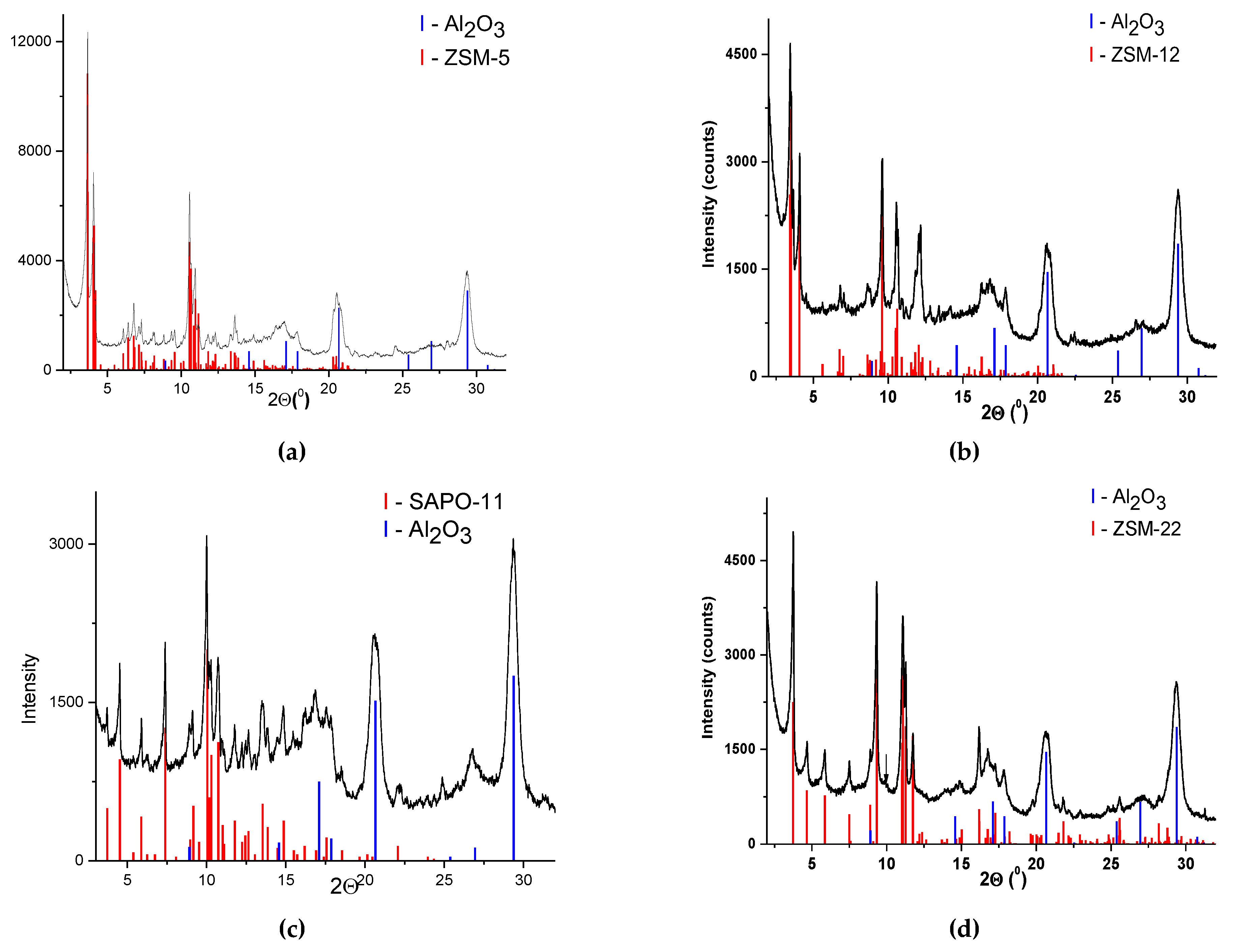

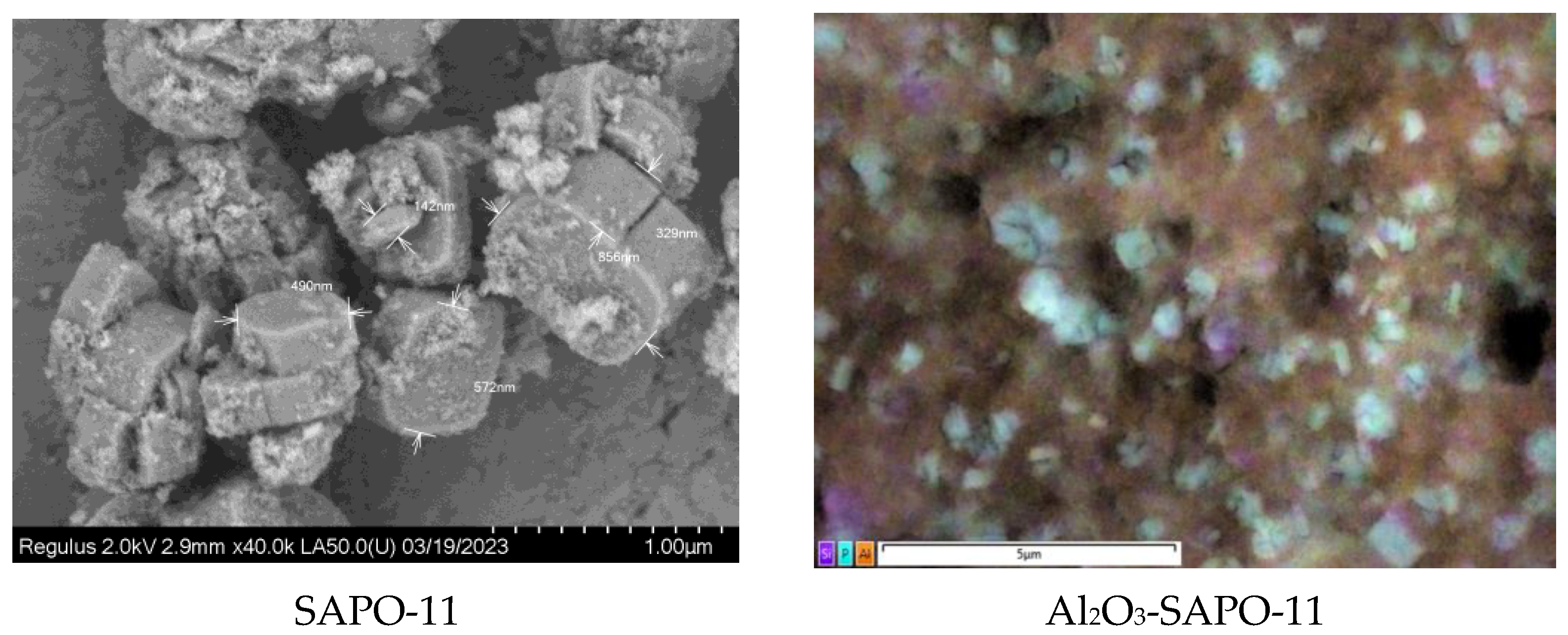
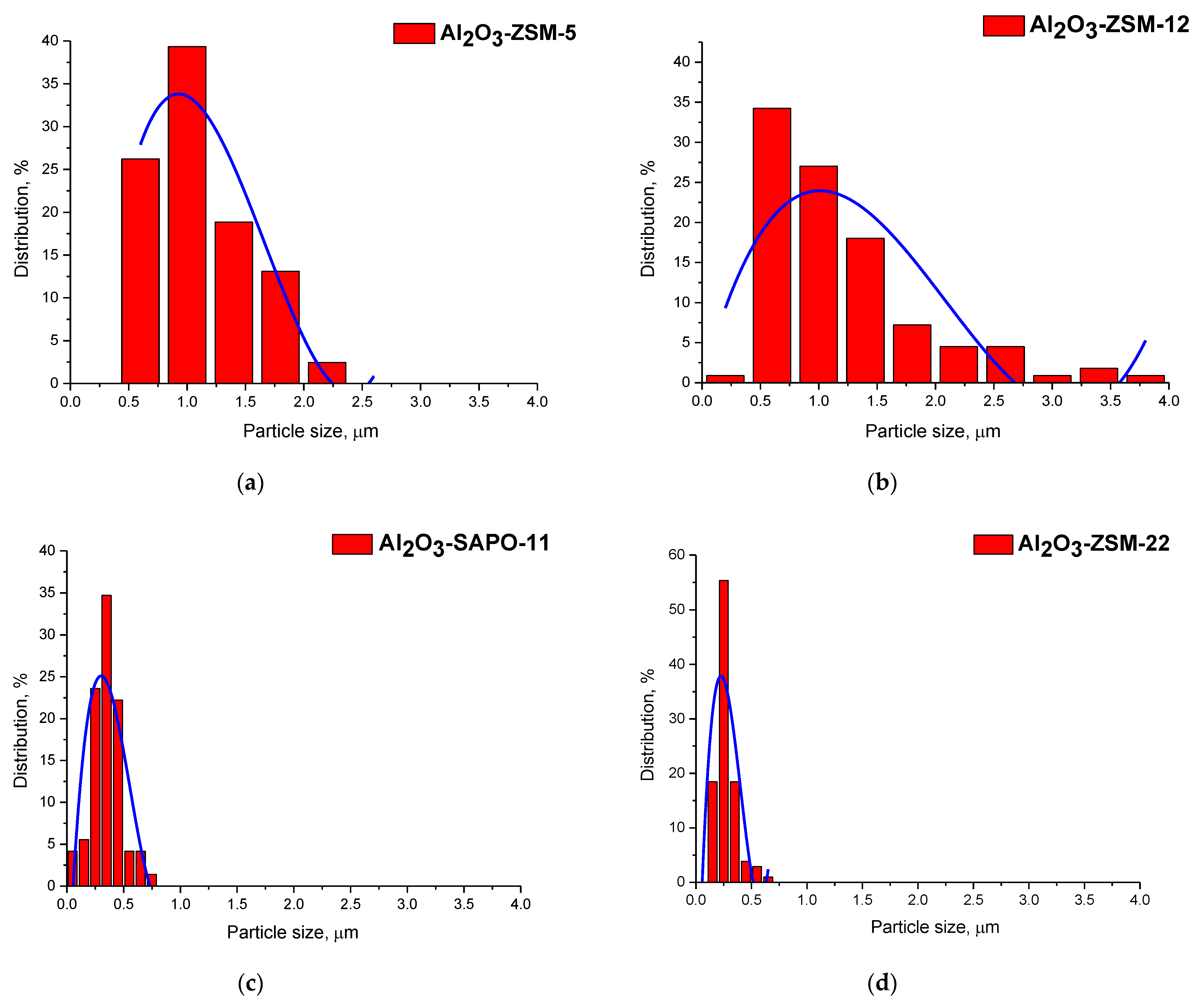
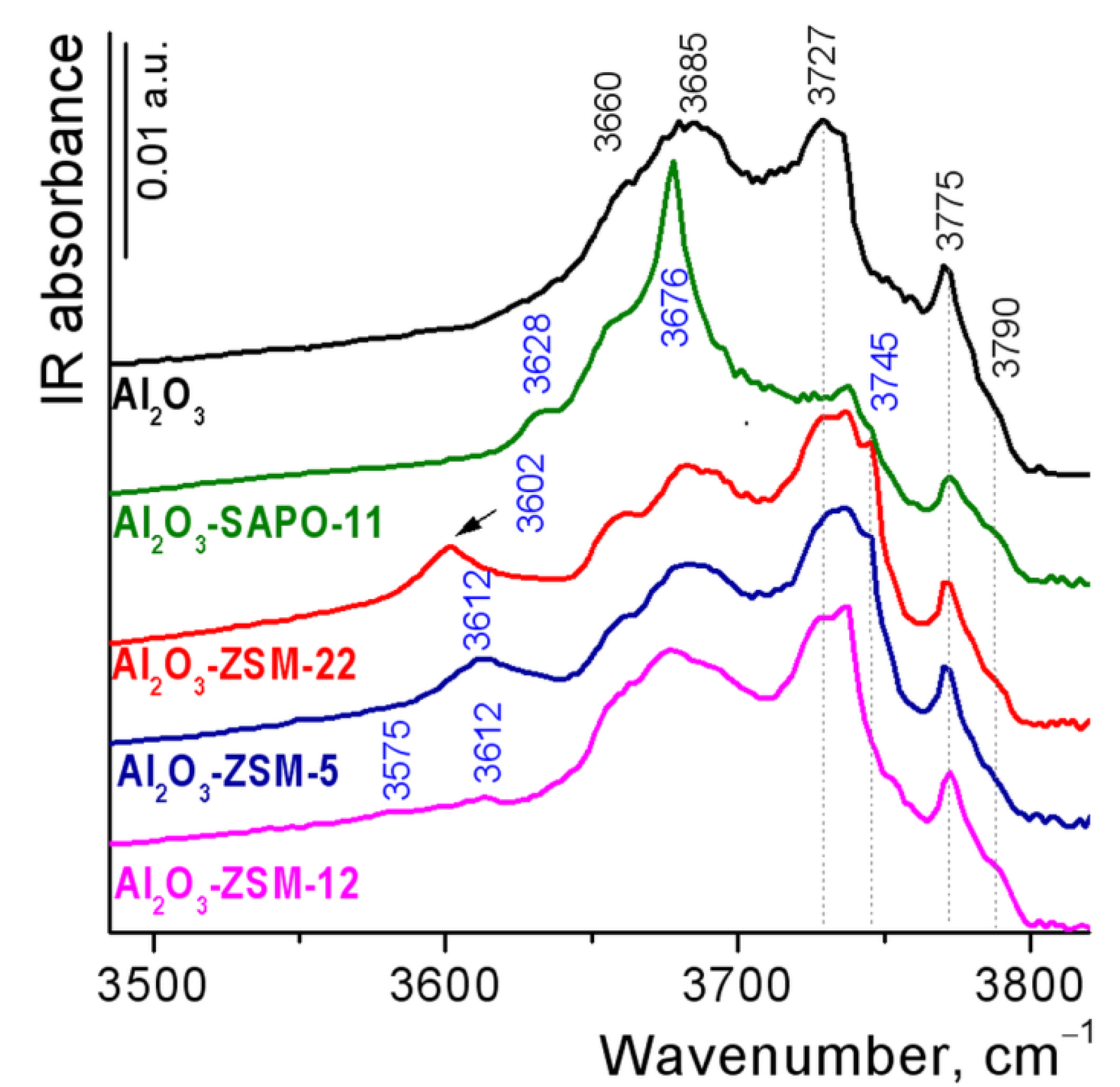





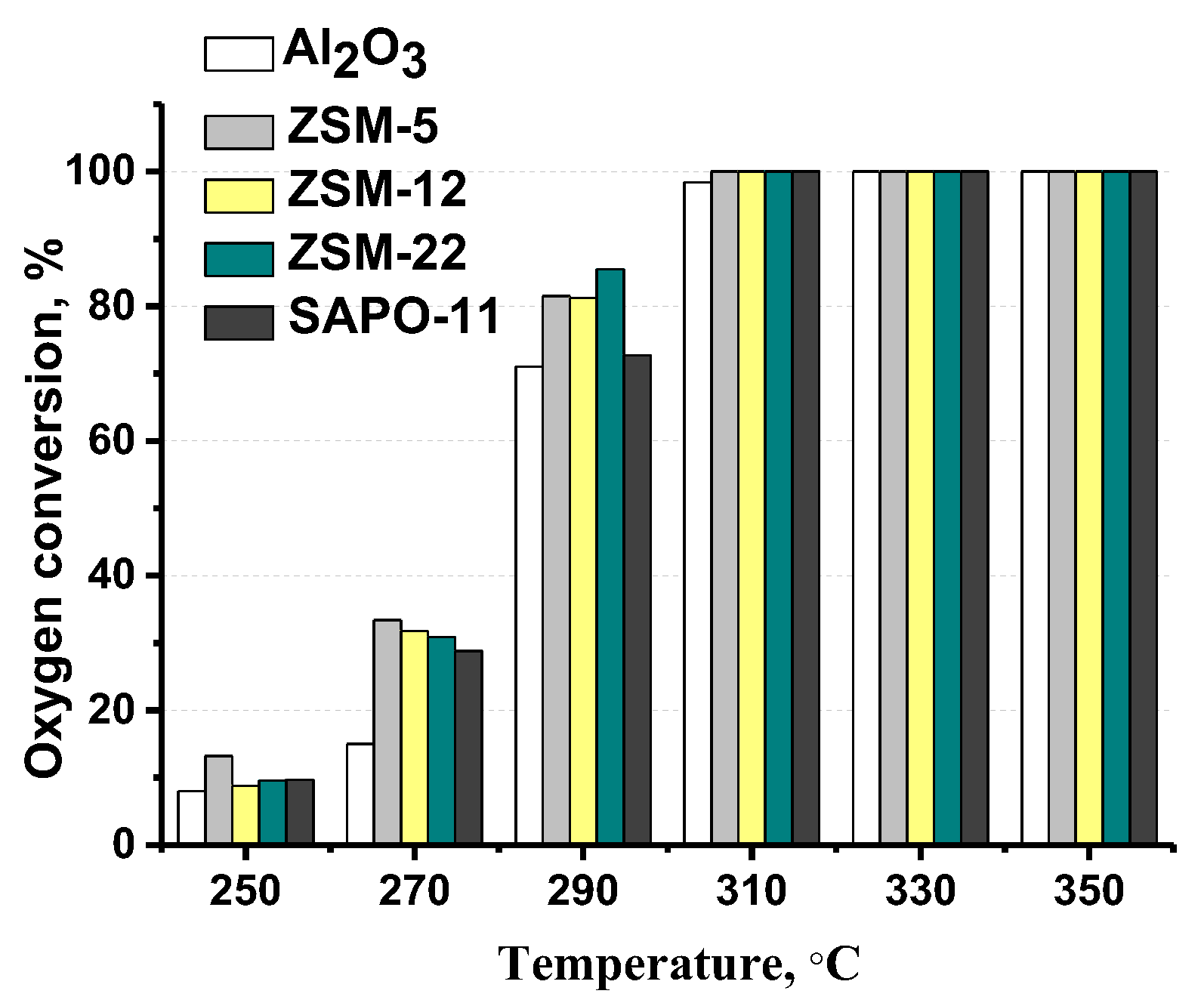
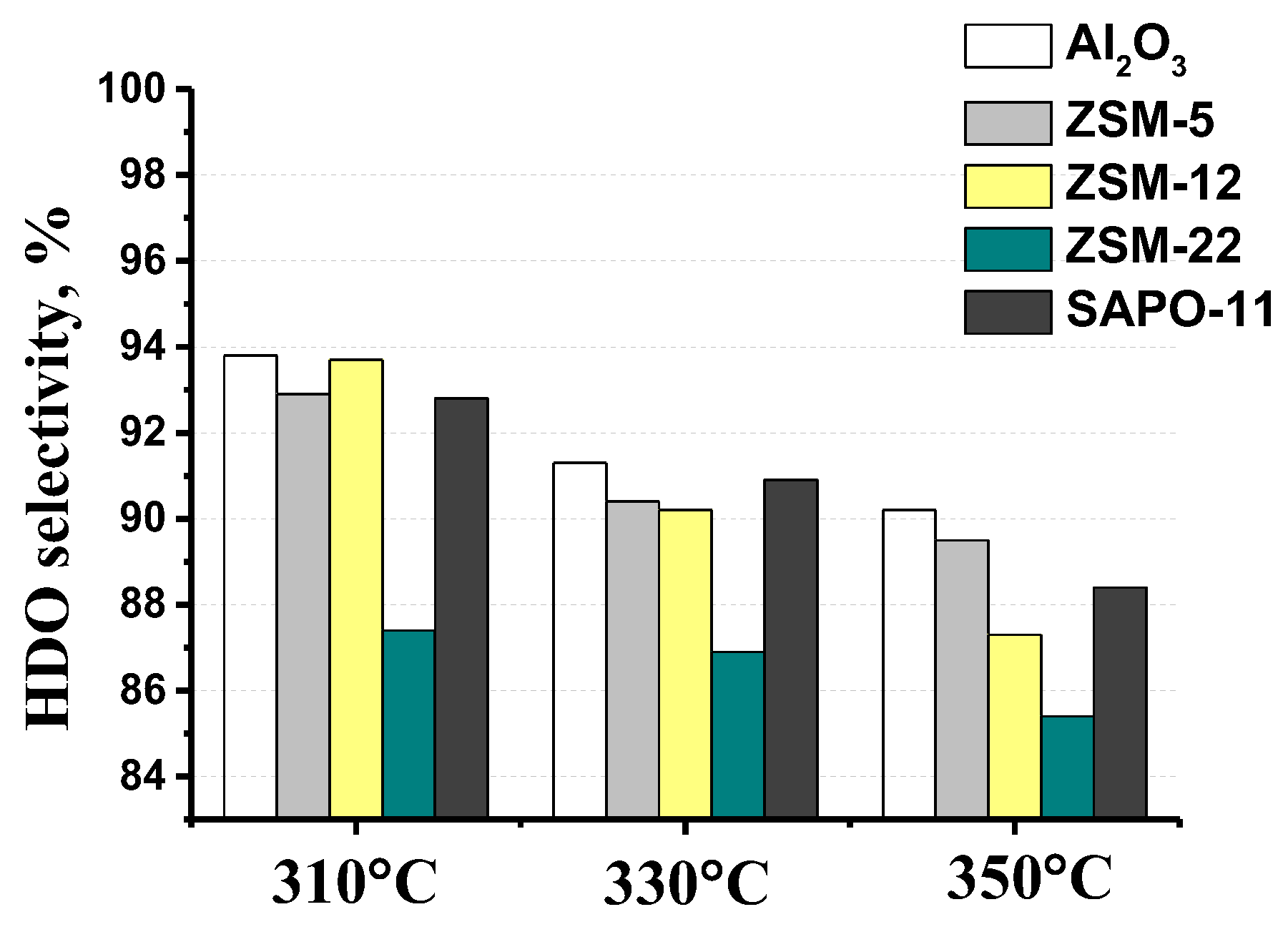


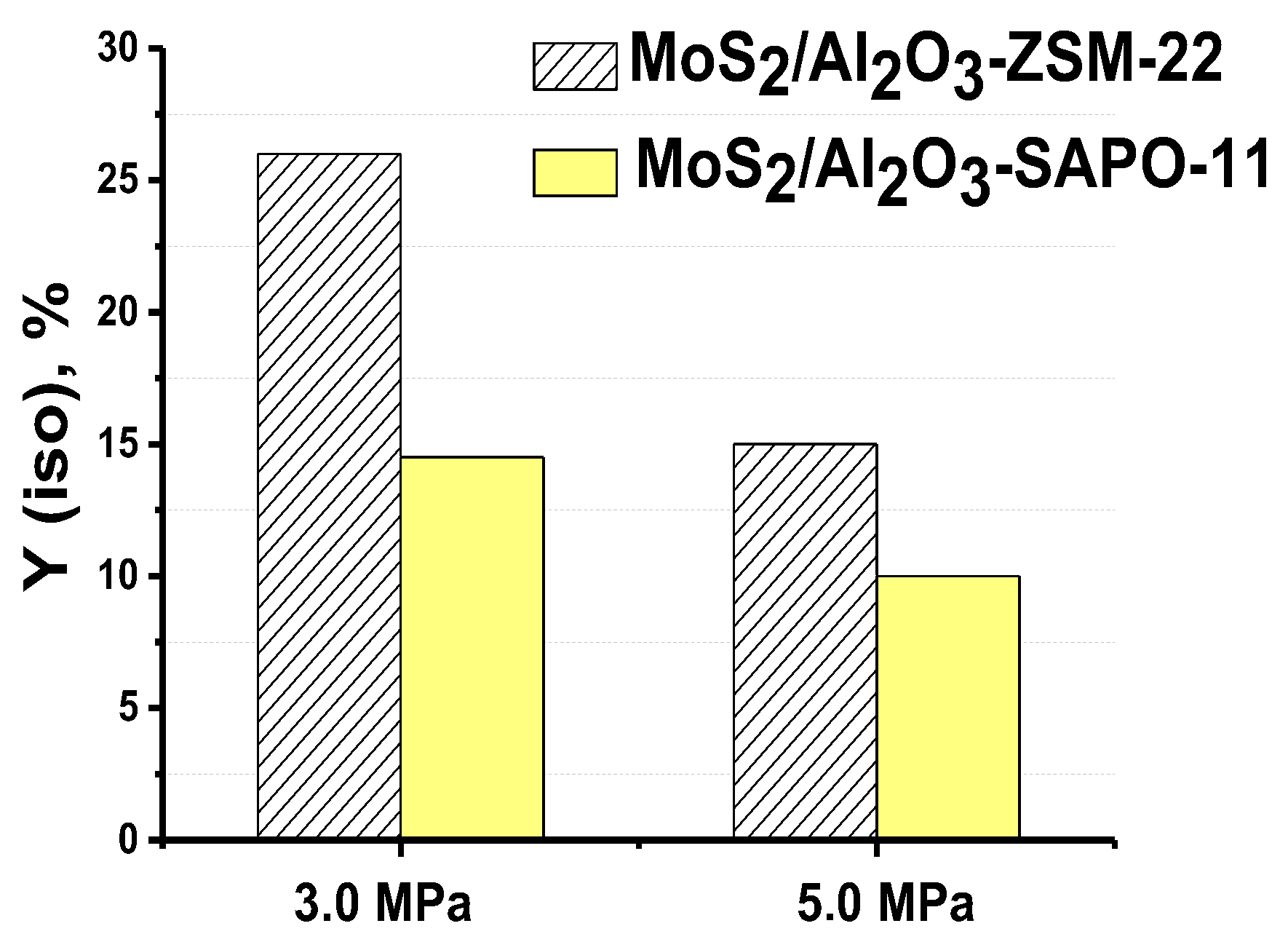
| Catalysts | Mo, wt.% | Support | Textural Properties of the Support | ||
|---|---|---|---|---|---|
| Surface Area, m2/g | Pore Volume, cm3/g | Pore Diameter, nm | |||
| Mo/Al2O3 | 6.95 | Al2O3 | 133 | 0.66 | 25.1 |
| Mo/Al2O3-ZSM-5 | 6.90 | Al2O3-ZSM-5 | 202 | 0.48 | 25.6 |
| Mo/Al2O3-ZSM-12 | 6.96 | Al2O3-ZSM-12 | 165 | 0.49 | 22.8 |
| Mo/Al2O3-ZSM-22 | 6.90 | Al2O3-ZSM-22 | 175 | 0.53 | 25.5 |
| Mo/Al2O3-SAPO-11 | 6.97 | Al2O3-SAPO-11 | 177 | 0.42 | 22.6 |
| Al2O3-Zeolite Composites | Type of Zeolite Sites | IR Frequency Shift/cm−1 | BAS Concentration (μmol g−1) | |
|---|---|---|---|---|
| ΔνOH…CO a | ΔνCO b | |||
| Al2O3-ZSM-5 | Framework Si-O(H)-Al groups | –317 | 8.1 | |
| Extra-framework Si-O(H)…Al3+ groups | –(260 ÷ 270) | +33 | 1.8 | |
| Al2O3-ZSM-22 | Framework Si-O(H)-Al groups | –320 | 11.4 | |
| Extra-framework Si-O(H)…Al3+ groups | –(260 ÷ 270) | +33 | 1.0 | |
| Al2O3-ZSM-12 | Framework Si-O(H)-Al groups | –333 | +35 | 2.7 |
| Extra-framework Al-OH groups | –(200÷196) | +28 | 2.6 | |
| Al2O3-SAPO-11 | Framework Si-O(H)-Al groups | –258 | +30 | 7.4 |
| P-OH groups | –(202÷198) | +27 | ~4 c | |
| Material | SiO2/Al2O3 Mole Ratio | Framework Type | Channels | Size of Channels |
|---|---|---|---|---|
| ZSM-5 | 280 | MFI | 3D, 10 MR | 5.3 × 5.6 Å [010] 5.1 × 5.5 Å [100] [58] |
| ZSM-12 | 280 | MTW | 1D, 12 MR | 5.6 × 7.7 Å [010] [59] |
| ZSM-22 | 97 | TON | 1D, 10 MR | 4.6 × 5.7 Å [001] [58] |
| SAPO-11 | SiO2/Al2O3/P2O5 = 0.25/1.0/0.8 | AEL | 1D, 10 MR | 3.9 × 6.3 Å [001] [60] |
Disclaimer/Publisher’s Note: The statements, opinions and data contained in all publications are solely those of the individual author(s) and contributor(s) and not of MDPI and/or the editor(s). MDPI and/or the editor(s) disclaim responsibility for any injury to people or property resulting from any ideas, methods, instructions or products referred to in the content. |
© 2023 by the authors. Licensee MDPI, Basel, Switzerland. This article is an open access article distributed under the terms and conditions of the Creative Commons Attribution (CC BY) license (https://creativecommons.org/licenses/by/4.0/).
Share and Cite
Vlasova, E.; Zhao, Y.; Danilova, I.; Aleksandrov, P.; Shamanaev, I.; Nuzhdin, A.; Suprun, E.; Pakharukova, V.; Tsaplin, D.; Maksimov, A.; et al. Bifunctional MoS2/Al2O3-Zeolite Catalysts in the Hydroprocessing of Methyl Palmitate. Int. J. Mol. Sci. 2023, 24, 14863. https://doi.org/10.3390/ijms241914863
Vlasova E, Zhao Y, Danilova I, Aleksandrov P, Shamanaev I, Nuzhdin A, Suprun E, Pakharukova V, Tsaplin D, Maksimov A, et al. Bifunctional MoS2/Al2O3-Zeolite Catalysts in the Hydroprocessing of Methyl Palmitate. International Journal of Molecular Sciences. 2023; 24(19):14863. https://doi.org/10.3390/ijms241914863
Chicago/Turabian StyleVlasova, Evgeniya, Yiheng Zhao, Irina Danilova, Pavel Aleksandrov, Ivan Shamanaev, Alexey Nuzhdin, Evgeniy Suprun, Vera Pakharukova, Dmitriy Tsaplin, Anton Maksimov, and et al. 2023. "Bifunctional MoS2/Al2O3-Zeolite Catalysts in the Hydroprocessing of Methyl Palmitate" International Journal of Molecular Sciences 24, no. 19: 14863. https://doi.org/10.3390/ijms241914863





